![]()
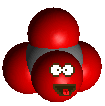 |
More Molecules with |
![]()
Rudolphomycin and RednoseRudolphomycin is a antitumor antibiotic compound. It was named following a series of such molecules derived from 'bohemic acid' - which was given its name because the discoverer Dr Nettleton was an avid opera fan and called it after the Puccini opera La Bohème. Derivatives of this were then given names from characters in the opera, such as mussettamycin and marcellomycin, after Musetta and Marcello, and rudolphomycin after the character Rudolph. On degradation of rudolphomycin, a new sugar was obtained, which was christened 'rednose'. This rather silly name was probably allowed to stand since the paper was submitted on December 21st 1978, and the journal editor probably had the Yuletide spirit! Thanks to Janet McBride for suggesting these Christmas-ey molecules. More info: J. Am. Chem. Soc. 101 (1979) 7041. |
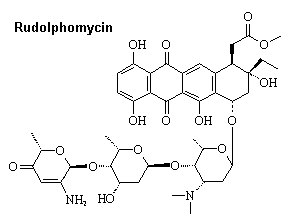  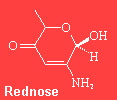 |
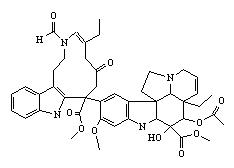 |
CatherineI don't know much about this molecule except that its name comes from the plant Catharanthus roseus. I'm surprised, though, that it's not wheel shaped... |
Complicatic AcidThis molecule didn't get its name because it was complicated to make, rather from the plant Stereum complicatum from which it was isolated. |
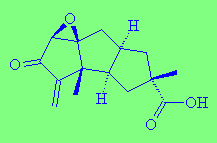 |
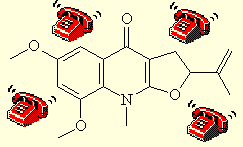 |
PtelefoloneThis molecule rings a bell...It gets its name from the hop tree Ptelea trifoliata, but I don't know much else about it. |
BirdcageThis molecule is so called because it, um, resembles a birdcage, duh. Maybe it should have been used to capture the aberrant pigeon from cristane, above... |
 |
BON-BONsThese ring structures are not what makes French sweets taste sweet. Heterocyclic dimers like the one shown in the picture (where you vary the R, R' and R" groups) are named from the fact that the ring atoms in sequence spell out BON-BON. |
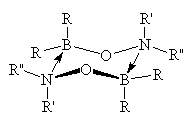 |
 |
Sonic HedgehogFruitfly genetics has a rich history of 'creative' nomenclature, often
based on the appearance of flies that have the gene in a mutated form. One
of these mutated genes made fruitfly embryos look like hedgehogs, since
their spines grew all over their body rather than just in specific places
- so it was name the 'hedgehog' gene. The vertebrate analogue was called
'Sonic' Hedgehog in order to distinguish it from its insect-forming
version, and was given the abbreviation Shh. Geneticists studying other
organisms are happy to elaborate on this when they can get away with it,
and there are other variety of hedgehog genes called Indian hedgehog
(Ihh), Desert hedgehog (Dhh), and even 'Tiggy-Winkle hedgehog' (TWhh)!
There are also genes called Sleeping Beauty, Tubby, and most recently the
puberty gene, "Harry Potter". Thanks to Greg Valure for suggesting this gene, and to Richard Williams from the Institute of Cancer Research and Geraldine VdA for providing some of the info about it, to David Bradley for the other gene names, and to Jan Linders for the robotnikin details. More fruitfly gene names and their stories can be obtained from http://www.flynome.com/, and thanks to Jeremy Bracegirdle for supplying this link. |
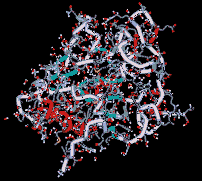 |
 |
JesteroneThis playful and mischievous molecule is found in a fungus, Pestalotiopsis jesteri, which lives inside yew trees. Thanks to Christopher Wells for info on this molecule. |
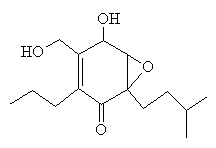 |
ParisiteThis mineral sounds like it grows on other minerals. It is found in Columbia, and it's named after J. J. Paris, who was a mine proprietor at Muzo, north of Bogota, Columbia. It is a member of the Bastnasite group of complex carbonate-fluoride minerals, and has the formula Ca(Nd,Ce,La)2(CO3)3F2. Thanks to Tanuki the Raccoon-dog for info on this mineral. |
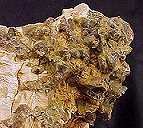 |
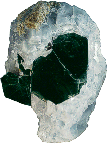 |
ClintoniteThis mineral sounds like it should be found in close proximity to 'internite' or 'lewinskyite'..., but it was actually named after American Statesman De Witt Clinton (1769-1828), not the notorious ex-President. Its formula is Ca(Mg,Al)3(Al3Si)O10(OH)2 (a calcium magnesium aluminosilicate hydroxide mineral), and it's related to margarite. It is found abundantly in the northern extent of New York. Thanks to Friedrich.Menges and Steven A. Hardinger for info on this mineral, and to Hans Hillewaert for the link to the image. |
SodamideThis is the shorthand name given to the common chemical, sodium amide, NaNH2. It sounds like it belongs in close proximity to other molecules in this list, such as arsole, anol, skatole, and maybe fruticolone...But I'm not letting it get anywhere near miazole! Thanks to Germanicus Hansa-Wilkinson for suggesting this molecule. |
 |
CentaureidinCentaurs are creatures which are half horse, half human. The molecule centaureidin got its name because it was extracted from a flower called Centaurea corcubionensis, which is related to the cornflower. It was discovered along with a molecule named centaurein, found in the same plant. Thanks to Victoria Barclay from ACD in Toronto and to ShadowFox for providing the info on this molecule. Here is a scientific article about Centaureidin. |
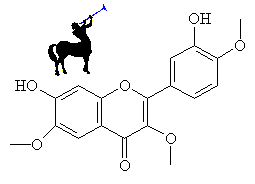 |
Magic Acid'Magic Acid' is the name given to one of the strongest of the inorganic 'superacids'. It is made by mixing together antimony pentafluoride (SbF5) and fluorosulphonic acid (HSO3F), and it is so strong (pKa = -20) that it is capable of protonating even saturated alkanes, like methane, to produce carbonium ions. On a similar name theme, Magic Factor-1 (derived from the acronym for Met-Activating Genetically Improved Chimeric Factor-1) is an engineered protein that helps keep certain cells alive and which may be used to treat muscular dystrophy. It's been shown to improve the running speed of mice which have previously had wasted leg muscles...magic indeed! Thanks to Indranil Sen from the Utah State University for suggesting magic acid, and to Rob Towart for Magic F-1 (See: M. Cassano, et al, PLoS ONE 3, (2008) e3223). |
 |
CrocidoliteThis has nothing to do with crocodiles, but is actually the name of the mineral form of blue asbestos, with formula Na2Fe5Si8O22(OH)2. It either got its name from the Greek word for 'woolly', or it was named from the geographic location of where it was first discovered. viz. the Crocodile River Valley in South Africa. This is just outside Nelspruit in Mpumalanga South Africa (look on the Eastern part of a SA map - next to the Kruger National Game Park). Thanks to Indranil Sen for suggesting this molecule and to Stuart Kidd and Grant Little for providing some of the information about it. |
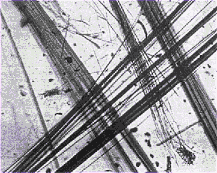 |
Piano StoolThese are a group of molecules made from a transition metal bonded to a cyclopentadienyl ligand, so that the resemble a 3-legged piano stool. I don't know if molecules have been made with other numbers of 'legs', such as milking stools, etc. Thanks to Sean Pearce for suggesting this molecule. |
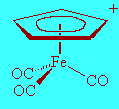 |
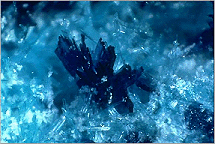 |
ShattuckiteThis mineral sounds painful, but is actually just named after the locality in which it is found, the Shattuck mine in Arizona. Its actual formula is Cu5Si4O12(OH)2. Thanks to Martin Harris for suggesting this mineral. |
G(olf) proteinsThese are a class of proteins called G-type proteins, some of which are linked to the olfactory system - hence the name G(olf) proteins. They help trigger the biochemical synthesis of neurotransmitters, which eventually leads to signalling, and gives us a sense of smell. Thanks to Boaz Laadan for suggesting this mineral. More info at: http://www.leffingwell.com/olfact3.htm |
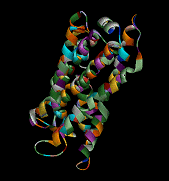 |
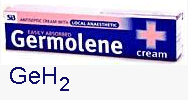 |
GermyleneThe GeH2 radical is called germylene, which is similar to an antiseptic ointment found in the UK called Germolene. I doubt that germolene contains germylene, though, as GeH2 is very toxic... Thanks to Victor Sussman for suggesting this molecule. |
KhanneshiteIt's amazing how this name got past the International Mineralogical Association when they approved the new mineral name. It was named after the discovery locality at Khanneshin, Afghanistan. All minerals have the suffix '-ite'. and so the name they gave to this mineral is - Khanneshite. I can only presume that there were no Scots on the committee that approved the name... I can't find any photos or structural images of khanneshite, so the image on the right is actually of the burbankite structure which, according to the literature is identical to that of khanneshite. Thanks to Brian Jackson from the National Museums of Scotland for suggesting this mineral. |
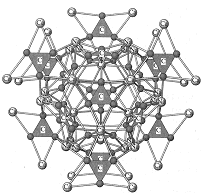 |
SEXSEX is the official abbreviation of sodium ethyl xanthate, which
is a flotation agent used in the mining industry. Apparently you can get
SEX in both solid and liquid forms (should that be hard and wet SEX?), and
according to Australia's
National Industrial Chemicals Notification and Assessment Scheme signs
of high exposure to SEX include 'dizziness, tremors, difficulty breathing,
blurred vision, headaches, vomiting and death'. Sound familiar...? Thanks to Joseph Wiman and for suggesting this molecule and Nicholas J. Welham for some of the info about KAX. |
 |
 |
AustinAustin has nothing to do with Austin cars, Austin Texas, or even Austin Powers...it's actually a mycotoxin, which comes from the fungus Aspergillus ustus, which might have given it it's name but I'm not sure. Thanks to Chris Fellows for suggesting this molecule and to Mark Johnston for suggesting how it got its name. |
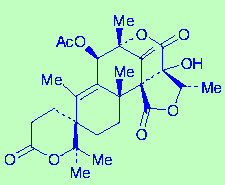 |
Technetium Cow'Cow' terminology comes from the nuclear industry, and it has nothing to do with the unfortunate cattle that live near nuclear power plants. A radionuclide, such as 99Mo (as its ammonium salt), is stored in a column, called a 'cow'. Its decay product, technetium-99m, is continually produced, and it can be flushed out of the "cow column" in a process called 'milking the cow'. The 'technetium cow' isotope is then used in bone scans, and has a 6 hour half-life. And I'm told that there used to be an 'Americium Cow' in Harwell in the 1950s. On a related theme, molybdic acid anhydride (MoO3) is often referred to as 'Moo'. Thanks to 'Plutonium' Page Sebring for providing the info about this element, Ian Ferguson for the Am Cow info, and to Jonathan Montgomery for info on Moo. |
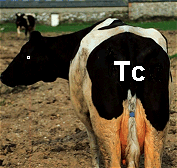 |
BowtiedieneThis is another molecule named after its shape - although the preferred name is spiropentadiene. Thanks to Isaiah Shavitt for providing the info about this molecule. |
 |
 |
WarfarinThis molecule sounds like it could be a warfare agent, and it is...if you're a rat. It's a rat poison which stops the blood clotting, so the rats bleed to death. It also has medical uses in blood thinning and clot prevention. Apparently it gets its name since WARFarin was the first patentable product of the Wisconsin Alumni Research Foundation (WARF). An interesting story about warfarin is that it may have been used to kill Stalin. Thanks to Charles Turner and Michael Bailey and Larry Baum for providing the info about this molecule. |
(R)-DICHEDThis is the abbreviation for (R,R)-1,2-dicyclohexyl-1,2-ethanediol. The authors of the paper which describes it (Organometallics, 2001, 20, 2920) state "a number of DICHED boronic esters were screened by NMR...". I wonder who the real DIC-HED is? Thanks to Alex Yuen of the University of Sydney for providing the info about this molecule. |
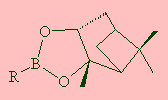 |
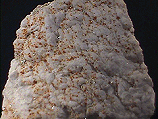 |
MicroliteMicrolite is not one of the components of a small airplane, but is a tantalum/niobium oxide mineral that can be slightly radioactive. Its correct formula is: (Ca, Na)2Ta2O6(O, OH, F). Thanks to Neil Brew for suggesting this mineral. More info can be found here. |
 |
beta-BuTXThis molecule sounds like the sales pitch for an exercise regime (get better buttocks using this!), but it's actually a snake venom with full name beta-Bungarotoxin). maybe the venom is more potent if the snake bites you on the Butx. :-) Thanks to Satan's Little Helper and Joerg Fruechtel for info on this molecule. |
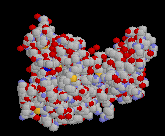 |
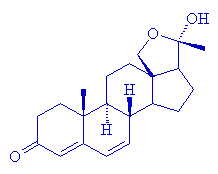 |
MirasorvoneThis molecule is part of the defensive chemistry of Thermonectus marmoratus, a beetle recently named the "sunburst diving beetle". The discoverers' at Cornell University named it in honour of the actress Mira Sorvino (right), who, as Dr Susan Tyler in the motion picture Mimic, successfully confronted the ultimate insect challenge. Thanks to Andy Cal for info on this molecule, and more info is available at: http://www.pnas.org/cgi/content/full/95/6/2733. |
 |
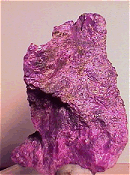 |
StichtiteStichtite is a lilac coloured mineral which is a hydrated magnesium chromium carbonate hydroxide. This is fairly common as streaks and small lenses in the green Serpentine in the metamorphic rocks of Western Tasmania, but is very rare elsewhere. It was named after Robert Sticht, a director of a mining company. Thanks to Martin Harris for info on this mineral. |
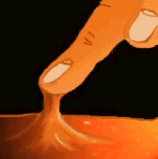 |
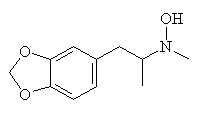 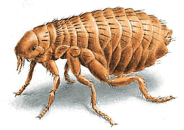 |
FleaThis is the commonly used name for the amphetamine, N-hydroxy-N-methyl-3,4-methylenedioxymethamphetamine (the N-hydroxylated version of MDMA, Ecstasy). The origin of its name is a bit strange, and is related to the fact that a commonly used code name for the parent compound, MDMA was ADAM. The 6-Methyl homologue was then called MADAM, and, following this pattern, the 6-Fluoroanalogue was to be FLADAM. So, with the N-Hydroxy analogue, the obvious choice was HADAM. But this brought to mind the classic description of Adam's earliest complaint, an infestation of fleas. The poem was short and direct: "Adam had 'em." So, in place of HAD 'EM, the term FLEA jumped into being. See: http://www.erowid.org/library/books_online/pihkal/pihkal081.shtml for a full description of this naming process. Thanks to J.J. Keating for info on this molecule. |
Wheelbarrow MoleculeHere's a molecule that has been designed to look like a wheelbarrow. It doesn't seem to have a full name yet, so it's just called Wheelbarrow Molecule. What's next, a molecular lawn mower? Pruning shears? Thanks to Plutonium Page for info on this molecule, and the full paper can be seen at: Tet. Lett. 44 (2003) 6261. |
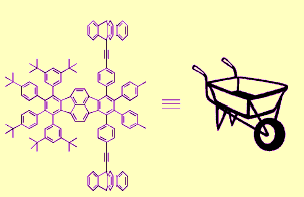 |
NanoPutian MoleculesAnd today's award for the 'How did they possibly get a grant to do that?' paper, goes to the J. Org. Chem. article by Chanteau and Tour from Rice University in Texas. It concerns making anthropomorphic molecules - i.e. molecules that look like humans...but why anyone would want to do this I don't know... They have been named NanoPutians, after the little men from Lilliput in the book 'Gulliver's Travels'. They come in many forms - the basic building block is the NanoKid (shown right), and from this other variants can be made, such as NanoAthlete and NanoBaker. Thanks to Neil Edwards for suggesting these molecules. |
 |
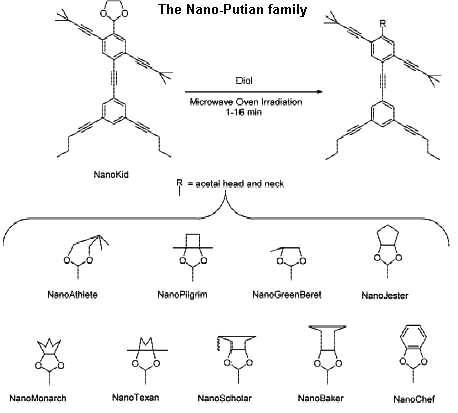 |
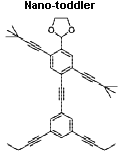 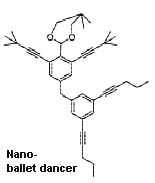 |
 |
Nanocars and NanotrikesThese are the perfect vehicles for driving Nanoputians around their nanoworld. They are made from a rigid framework of benzenes and acetylene groups, with either three or four C60 molecules attached at the ends as 'wheels'. I always wanted a compact... Thanks to Andrew Byro for suggesting these molecules. |
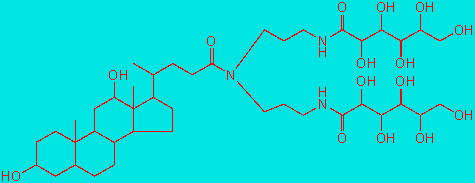 |
BIG CHAPThis wonderfully named molecule has nothing to do with reproductive hormones, but is actually a detergent with proper name N,N-bis(3-D-gluconamidopropyl)cholamide. Apparently the molecule has reduced electrostatic interactions that prevent your BIG CHAP getting stuck in a chromatography column... Thanks to Stephen FTM Thompson for suggesting this molecule. |
ASSThis is the commonly used acronym for argininosuccinate synthetase, which is a chemical found in the brain. So it seems some people really do think with their ASSes... Thanks to Allart Kok for suggesting this molecule. |
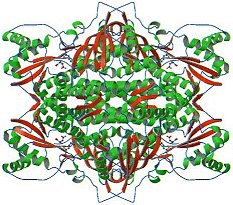 |
 |
Horseradish PeroxidaseThis is the version of the peroxidase enzyme that is isolated from the horseradish plant. Like all peroxidases, it converts harmful peroxide molecules (H2O2) into water molecules (H2O). It is also used to label proteins and nucleic acids as an alternative to radio labelling. The molecule to be labelled is attached to the horseradish peroxidase molecule, and the mixture is then exposed to a substrate that changes from clear to coloured when it is oxidized by HRP. When some of the variations of this enzyme are used as a labels for antibodies, they go by names such as anti-mouse, anti-rabbit, and worryingly...anti-human. Thanks to Andrew Patterson for suggesting this molecule. |
 |
PorkaneI'm pretty certain this is a spoof molecule, since one of the carbons has 5 bonds. These pig-shaped molecules, where the 'tail' can point up or down, are apparently isolated from porcine lard (pig fat). There are various derivatives of this, including norporkanone, epiporkanone and neoporkanone. For more info on the porkanes, see here. Thanks to Victor Nikolaev for suggesting this molecule. |
 |
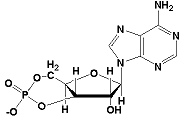 |
CAMPThis is actually short for cyclic adenosine monophosphate (cAMP) and is a signalling molecule which can be found in almost all eukaryotic organisms. For example, it is used as a nutrient sensor in yeast, and is one of the building blocks of DNA. I wonder if it's responsible for the so-called 'gay gene'... Thanks to Han Lim for suggesting this molecule and to Tom for info about it. |
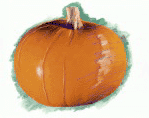 |
CucurbiturilThis molecule, which is shaped like a Halloween Jack'o'Lantern, is named after the Latin word for pumpkin (Curcubita pepo). It is now finding lots of use in medical drugs or in potential molecular electronic devices due to the fact that other long thin molecules can be threaded through the hole in the centre to make so-called 'rotaxanes'. |
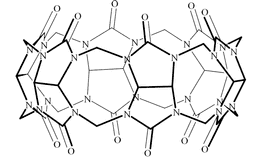 |
Old Yellow EnzymeThis is a flavoprotein that reversibly oxidises NADPH to NADP and a reduced acceptor. In fact, yellow enzymes are any of a number of enzymes having a flavin as a prosthetic group. Historically, NADPH dehydrogenase (occurring in plants and yeast) was called the Old Yellow Enzyme to distinguish it from D-amino acid oxidase, known as, of course, the New Yellow Enzyme. Thanks to John Moody for suggesting this enzyme. |
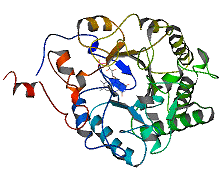 |
 |
LadderaneLadderane is a chain of fused cyclobutane rings that make up the bulk of dense membranes in certain unusual bacteria. They were discovered in anammox bacteria, which anaerobically oxidize ammonia to dinitrogen. The staircaselike structure of cis-fused cyclobutanes has never before been seen in nature. The most abundant lipid in the bacteria is the methyl ester of a C20 fatty acid with five fused rings. Other ladderane lipids contain three fused cyclobutane rings attached to a cyclohexane. Thanks to Erik Holtzapple for suggesting this molecule. |
SnottitesThese are gelatinous, dripping microbial draperies ("mucus
stalactites") composed of elemental sulphur, iron oxide crusts, gypsum,
and densely packed bacteria, and are found in caves. They are formally
known as biovermiculations, although snottite is more descriptive.
Snottites are produced by sulfurphilic micro-organisms and drip sulfuric
acid with a pH of 0.3 to 0.7. Other microbial structures include "blue
goo," which are lavender structures attached to the walls of the cave, and
"red goo," a complex clay breakdown product containing clusters of
bacterial cells and having a pH ranging from 3.9 to 2.5. Other microbial
stalactites go by the fancifully names of "phlegm balls," "green slime,"
"punk rocks," "hairy sausages," "slime balls," and "beads on a
string." Thanks to Charles Turner for suggesting these. |
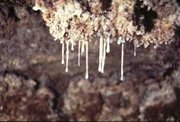 |
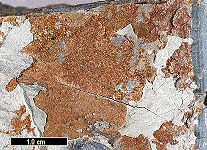 |
CoalingiteThis superbly named mineral takes some licking... It is actually an interstratified hydroxyl carbonate, but whenever anyone says its name, they normally lower their voices for the rest of the discussion, probably because it sounds like a contraction of coitus and lingus. But it was fact a mineral named after being found in the vicinity of the town of Coalinga, California, which was itself named after 'Coaling Station A'. Thanks to Phillip W Barak of the Virtual Museum of Minerals and Molecules for suggesting this mineral. |
NootkatoneThis molecule with a very silly name is used as a food additive to give grapefruit flavours, as well as in the perfume industry to give odours of citrus fruits and orange peel. It got its name from the yellow cedar, or Camaecyparis nootkatensis, which was itlself named after the native North American called the Nootka. Thanks to Jim Gobert for suggesting nootkatone and to ShadowFox for some info about its name. Click here for more info on the structure of nootkatin. |
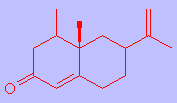 |
Any visitor to an Indonesian market or dinner table will almost certainly come across tempe (below left), though wonder what on earth it really is. Closely resembling a Camembert cheese in colour and texture with a mushroom-like aroma, tempe is in fact one of the world's first soybean foods. It is composed of cooked soybeans that have been fermented through by an edible fungus which, when mature (like a cheese) becomes an attractive and aromatic white cake suitable for a variety of uses in hundreds of local dishes.
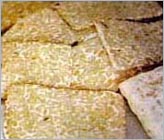
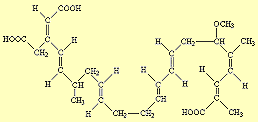
But deep in the mountain villages in Central Java, there used to be one rare
deadly variety of tempe. Very rare nowadays, and never sold openly
anymore, this tempe has killed hundreds. So dangerous is this
tempe that the government has banned manufacture of it and imposed a
prison sentences to anybody caught making or selling it, since this tempe
can contain a toxin more deadly than cyanide. This is tempe Bongkrek.
Made from coconut residue after the oil has been extracted, and nothing like
good safe soybean tempe, this tempe has the problem that it may
become contaminated with a deadly bacterium that lives on the fermented coconut,
called Pseudomonas. The coconut only grows the bacterium if it is heavily
contaminated, and may produce a deadly respiratory toxin called Bongkrekic
acid (above right). In 1988 one batch killed 40 people within two days and
over a hundred others were hospitalised. The community in this area, well aware
of the risks, have nevertheless continued to eat Bongkrek despite a ban by the
government, so irresistible is the taste and texture of this dangerous and
illicit pleasure.
Thanks to Tim Lyon for suggesting this molecule.
BarreleneThis molecule is closely related to bullvalene, and got its name from its similarity to the shape and structure of a barrel. Peter Lykos emailed me to say how it happened: "When Howie Zimmerman was getting started at Northwestern University I heard he had synthesized a molecule that in effect was three ethylene molecules condensed about two methyl axes. I could not give it the correct organic chemist's systematic name (I am a quantum chemist) but was fascinated by the notion that there might be a delocalization of six π-electrons around the molecule. So when I called him about its spectroscopic properties I referred to it as 'barrelene' following the idea that the lateral delocalization mught be like the staves of a barrel. He apparently liked that name so that became its trivial standard name". Thanks to Peter Lykos for suggesting this molecule. |
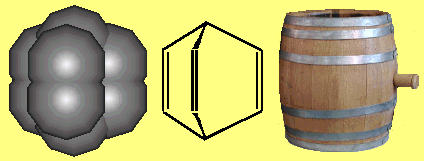 |
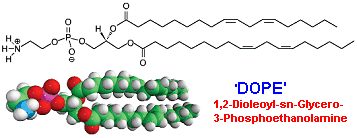 |
DOPEApparently, DOPE is commonly used by membrane chemists and biochemists - which is something I've always suspected... It's actually short for 1,2-Dioleoyl-sn-Glycero-3-Phosphoethanolamine, and it's a phospholipid used for research into membrane structures. A variant on this is called DOGS, so if you take DOPE, you may go to the DOGS... Thanks to Sophie Weiss of Leeds University for suggesting this molecule. More info from http://www.avantilipids.com/ |
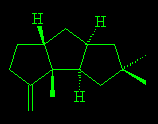 |
HirsuteneThis is an important biological molecule, although what its function is, I'm not sure. Perhaps it makes things hairy...? |
 |
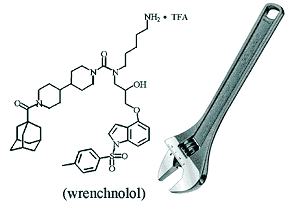 |
WrenchnololThis is a molecule that looks like a wrench, and is an anti-cancer drug. The "jaw" part of the compound mimics the helical interface of the activation domain of a transcription factor molecule, and the "handle" region accepts chemical modifications for a range of analysis. Thanks to Mackay Steffensen for suggesting this molecule. More details: J. Am. Chem. Soc. 126 (2004) 3461. |
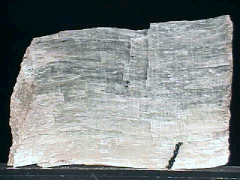 |
SillimaniteThis mineral wasn't named after the clumsy fool that tripped over it, but was named in honour of the American mineralogist Benjamin Silliman (1779-1864), who was a chemistry professor at Yale. It is a form of aluminium silicate, with no real value, except in Idaho, where the Clearwater River Valley has sillimanite cobbles that are carved into figurines and sold as souvenirs of Idaho. Thanks to Hope Nesmith for suggesting this mineral. |
IndenylThis sounds like it could be a pollutant found in some Egyptian rivers (i.e. in de Nile...), but it's actually a fusion of a cyclopentadienyl ring with a benzene ring, and is often used as a ligand for metallocene synthesis. Thanks to Kenneth Koon for suggesting this radical. |
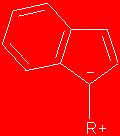 |
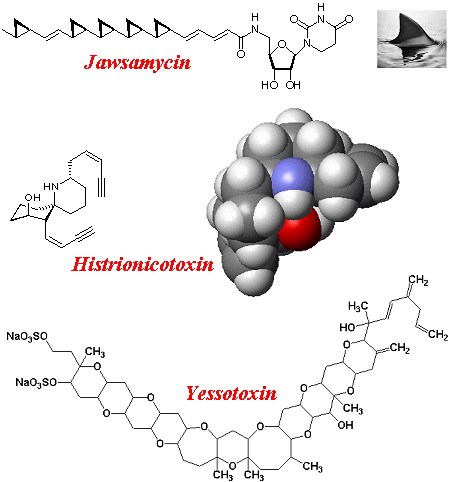 |
Jawsamycin, Histrionicotoxin and YessotoxinThese three molecules are all highly toxic, and are normally isolated
from biological sources. Jawsamycin was discovered in 1989 by Fujisawa, a
Japanese pharaceutical company, it has only recently been synthesised. The
metabalite is composed of a chain of five carbon triangles (cyclopropyls),
giving it its name because of the resemblance to shark's teeth. The
compound, however, has 10 chiral centres, points about which mirror images
of the molecule can form for a total of 1024 possible isomers, only one of
which is jawsamycin. Thanks to James Waterman from Nottingham University for suggesting these molecules. |
 |
Shikimic AcidHere's one for our German-speaking readers. Shikimic sounds very like the German word 'Schickimicki', which means a (snobbish) member of the in-crowd, a trend-setter, or a 'designer-label-wearing' sort of person, for example, Posh and Becks in the picture, left. Shikimic acid was first isolated from the Japanese flower shikimi, hence its name. It's used as a starting molecule in the synthesis of the anti-flu drug Tamiflu. Thanks to Kutti for suggesting this molecule. |
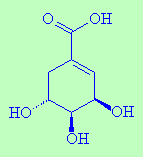 |
SoddyiteThis is a silicate mineral that was named after Frederick Soddy (1877-1956), the British physicist and radiochemist. In German it's known as Soddyit and it has the formula (UO2)2SiO4·2H2O. Thanks to Sean Pearce for suggesting this mineral. |
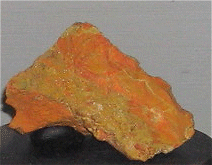 |
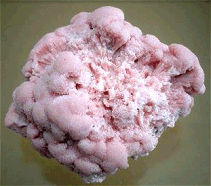 |
KutnahoriteThis is a another mineral that geology students love to mispronounce as "cuttin' a whore right". It's a CaMn(CO3)2 mineral originally from Czechoslovakia, and described as a massive and granular material occurring in veins. Its color is almost always some shade of pink, with well-developed cleavage with cleavage surfaces that are commonly curved (aren't they always?). Thanks to Dave Chapman and Jason Stouffer for suggesting this mineral. |
Mucic AcidPronounced 'Music acid', this is quite different to Acid Music... This chemical is obtained by the nitric acid oxidation of milk sugar (lactose), dulcite, galactose, quercite and most varieties of gum. It is also called Galactaric Acid. The "mucic acid test" in basic biochemistry lab is a well-known test for D- or L-galactose. The test is carried out by oxidising the sample with concentrated nitric acid; mucic acid crystals will form after leaving the solution overnight. Isn't chemistry great? Just add some acid, and you get some music... Thanks to Warut Roonguthai for suggesting this molecule. |
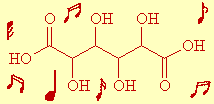 |
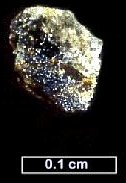 |
BurpaliteThis mineral with the wonderful name of burpalite, Na2CaZrSi2O7F2, is named after the Burpala massif in Buryatia, Russia. It sounds a bit like a medicine you give to babies to make them burp... Thanks to Willem Schipper for suggesting this mineral. |
 |
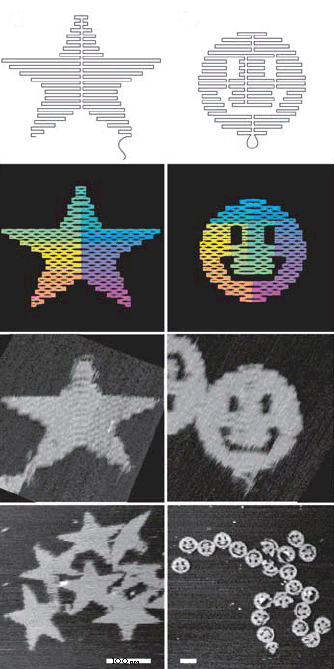 |
DNA origamiThis is a new development in which strands of various lengths of DNA can be 'stitched' together to make nanoshapes. The picture (left) shows AFM images of just some of these shapes (scalebar = 100 nm), including nanostars, and nanosmileys, but you can even write nanomessages using nanoletters and draw nanomaps of the world (see below).
One obvious application of patterned DNA origami would be the creation of a ‘nanobreadboard’, to which diverse components could be added. The attachment of proteins, for example, might allow novel biological experiments aimed at modelling complex protein assemblies and examining the effects of spatial organization, whereas molecular electronic or plasmonic circuits might be created by attaching nanowires, carbon nanotubes or gold nanoparticles. See: P.W. Rothemund, Nature 440 (2006) 297. |
OlympiadaneThis molecule consists of five tiny interlocking rings, which mimics the Olympic Games symbol, and so is named 'Olympiadane'. It was first made in 1996, in commemoration of that year's Olympic Games. The successful linkage of these highly complex synthetic molecules means that molecular chains of any length could be constructed with many applications, particularly in the areas of information storage systems and the creation of a 'molecular computer'. Thanks to Wendy Hunt for suggesting this molecule. |
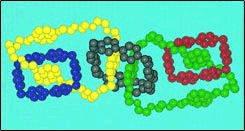 |
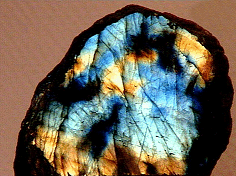 |
LabradoriteLabradorite is a silicate mineral that is named after Labrador in eastern Canada, where it was first discovered. Labradorite can produce a colourful play of light across cleavage planes and in sliced sections, called labradorescence, which sounds a bit like a perfume based on the smell of old dogs, or maybe the glow from a radioactive dog! The usually intense colours range from the typical blues and violets through greens, yellows and oranges. The colour display is from lamellar intergrowths inside the crystal. Thanks to Chris Miller for suggesting this mineral. |
 |
 |
Skunky ThiolThis molecule is what makes beer taste bad after it's been left exposed to sunlight for a few hours. The actual name is 3-methylbut-2-ene-1-thiol, or 3-MBT for short, but since it's related to molecules found in skunk spray, and it stinks, it's also known as skunky thiol. Only a few nanograms of this thiol in one litre of beer are enough to give the offensive flavour. Thanks to Matthew Latto for suggesting this smelly molecule. More info: http://www.rsc.org/publishing/journals/PP/article.asp?doi=b609337j |
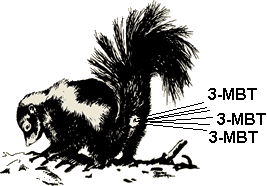 |
NaftazoneThis sounds like a pretty naff molecule. (For non-UK readers, 'naff' is English slang for poor quality, unfashionable or rubbish). It's used as a drug to protect blood vessels (a 'vasoprotector') - so, maybe it's not quite so naff after all. Its name comes from a contraction of its full name (1,2-naphthoquinone-2-semicarbazone) and has nothing whatsoever to do with the North American Free Trade Agreement (NAFTA). |
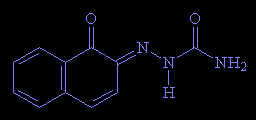 |
 |
NUNThis molecule could be habit-forming...It's actually a linear molecule of uranium nitride N-U-N, made by inserting uranium atoms into molecular N2. Thanks to Ian for suggesting this pious molecule. More info: R.D. Hunt, J.T. Yustein and L. Andrews, J. Chem. Phys., 98, (1993) 6070. |
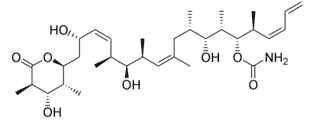 |
DiscodermolideCould this be John Travolta's favourite molecule? It's a recently
discovered polyketide natural product found to be a potent inhibitor of
tumor cell growth, and it gets its name since it was first isolated in
1990 from the Caribbean marine sponge Discodermia dissoluta. Since
the compound is light-sensitive, the sponge must be harvested at a minimum
depth of 33 metres - so, no disco lighting there then... More info: Wikipedia. Thanks to Dr Dave Fairley from Singapore for the info about discorhabdins. |
 |
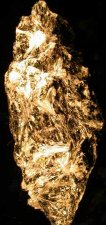 |
JimthompsoniteThis is actually a mineral - a mixture of iron and magnesium silicates, with formula (Mg;Fe2+)5Si6O16(OH)2 - that's found in a talc quarry, near Chester, Vermont, USA. It was named after Professor James Burleigh Thompson, Jr., who was an eminent petrologist of Harvard University in the 1940s and 1950s. This is a different Jim Thompson to the one who helped establish the silk industry in Thailand. There's a slightly different version (monoclinic crystal) of this mineral called clinojimthompsonite. Thanks to David French for suggesting this mineral. |
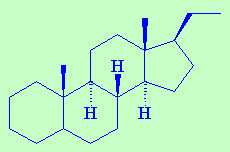 |
PregnaneThis is a steroid molecule that is the parent compound for many hormones, including the pregnancy hormone progesterone. Thanks to Vincent Schüler for suggesting this molecule. |
 |
Porphyrin Hamburger
This must give plenty of opportunity for derivatives along the lines of Porphyrin Cheeseburger. Or perhaps you could even attach penguinone to make a penguin burger? Or even attach a molecule of cocaine to get a burger and coke? Thanks to Matt Latto for suggesting this molecule. Original article: A. Yokoyama, T. Kojima, K. Ohkubo, S. Fukuzumi, Chem. Commun., (2007), DOI: 10.1039/b704994c |
|
Folk AcidThis is nothing to do with folk music, or even acid folk, it is simply a mis-spelling of folic acid, which itself gets its name from the Latin word folium meaning 'leaf'. This seems to be a particlarly common mis-spelling, and occurs even in scientific papers and textbooks (try it on google), maybe a result of word-processing programs automatically 'correcting' words they don't recognise, or just that scientists can't spell. Thanks to David Bromage from the Australian National University for suggesting this molecule. |
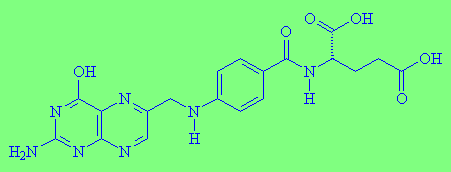 |
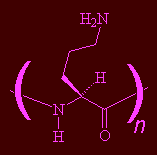 |
PORNNow that we have the word 'PORN' on this site, it'll either get banned or increase the hit rates hugely! Unfortunately, this PORN is simply the acronym for poly-L-ornithine, a molecule used in cell culture experiments. I suppose that to form a polymer it does involve lots of frantic couplings...so PORN maybe isn't such an inappropriate name after all. Thanks to Debbie Radtke for suggesting this molecule. |
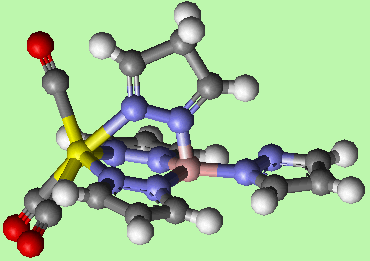  |
Scorpionate ligandsThe scorpionate ligand gets its name from the fact that the ligand can bind a metal with two donor sites like the pincers of a scorpion. The third donor site reaches over the plane formed by the metal and the other two donor atoms to bind to the metal, like a scorpion grabbing the metal with two pincers before stinging it. The most popular class of scorpionates are the tris(pyrazolyl)hydroborates or Tp ligands, and this is shown bonding to a Mn(CO)3 group, below. Another scorpion-like molecule is bis([1,2]dithiolo)-[1,4]thiazine, which is sometimes unofficially called sscorpionine. Thanks to Warut Roonguthai for suggesting these two molecules. For more details see: http://en.wikipedia.org/wiki/Scorpionate_ligand, or http://www.chm.bris.ac.uk/motm/sscorpionine/sscorpionine.htm |
 |
Bender's saltIs this what gay chemists put on their fries? (In the UK, a 'Bender' is a derogatory slang name for a male homosexual). Or maybe it's the salt that Bender from Futurama would use. It's potassium ethylthiocarbonate (C3H5KO2S) and is named after the German Chemist Friedrich Bender. For more details see: R. Fischer, G. Fessler, Pharmazie. 10 (1955) 349. |
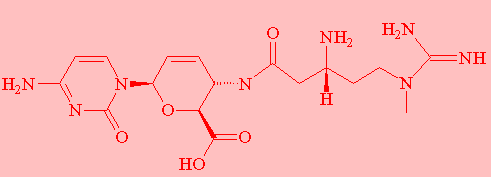 |
BlasticidinAnd here's one for the military, or maybe just a gung ho chemist (Blast its side in!). It's actually an antibiotic fungicide, and is also used in genetic engineering experiments to fuse pieces of DNA together to make resistant genes. For more details see: http://www.blasticidin.com/. |
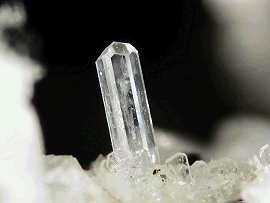 |
NoseliteA superb mineral name, that sounds like just the sort of thing a geologist needs to find his way around ina dark cave. It's a silicate mineral with formula Na8[SO4|Al6Si6O24], and named after the German mineralogist Karl Wilhelm Nose, and also goes by the name of nosean - as in "I've just been nosean around this rock face". For experiments involving real nose-lights, where the researcher stuck lightbulbs up the noses of volunteers to see how it affected their visual performance, see the wonderfully bonkers paper by N.E. Wetherick (Nature 266 (1977) 442.) For more details see: http://www.webmineral.com/. Thanks to Peter Rice for the Nature reference. |
 |
Brick Acid'Brick acid' is the nickname given to good old hydrochloric acid (a.k.a. muriatic acid), since it's commonly used by builders to clean up the mortar smudges in brickworks and paving. Some manufacturers sell 'brick acid' as a mixture of 10-30% aqueous HCl with added detergent and sulfuric acid. Thanks to Michael Buxton for suggesting this molecule. |
 |
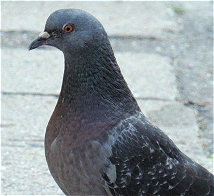 |
PigeonitePigeonite is a silicate mineral named after Pigeon Point in Minnesota where it was first found. It forms dark green crystals that are found in volcanic rocks on Earth and in meteorites from Mars or the Moon. Those darn pigeons get everywhere... Thanks to Dennis J. Walden for suggesting this mineral. |
![...and a pigeon rock. [from: http://www.webmineral.com/data/Pigeonite.shtml]](sillymolecules2_files/pigeonite.gif) |
MEANMEAN is definitely a mean molecule. It stands for monoethanolamine nitrate, which is an explosive used as a sensitiser in 'slurry explosives' (mixtures of ammonium nitrate, sodium nitrate, a gelling agent and water). Slurry explosives are sometimes used in mining and quarrying, but nowadays they are on various governments' watch-lists as potential terrorist weapons due to their ease of manufacture. I believe it's also used in small quantities as a fertiliser, and doesn't cost too much - so it's a favourite with mean gardeners. Thanks to Maxime Van den Bossche for suggesting this mean molecule. |
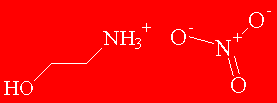 |
Star Wars 'Tie-Fighter' MoleculeIt looks like chemists are trying to outdo each other with making molecules which have weird shapes. This one is described in the paper as being shaped like the Tie-Fighters from the movie Star Wars, and may be used to harvest light in photoelectronic applications. Is this in order to stop everyone going to the dark side...? They are made from a central buckyball with two cyanine 'plates' on each side. Perhaps if many of these were joined together, they could make a light sabre...? Thanks to Jan Linders for suggesting this molecule. For more details see: F. D'Souza, S. Gadde, M.E. El-Khouly, M.E. Zandler, Y. Araki and O. Ito, J. Porphyrins & Phthalocyanines, 9, (2005) 698, "A supramolecular Star Wars Tie Fighter Ship: electron transfer in a self-assembled triad composed of two zinc naphthalocyanines and a fullerene." |
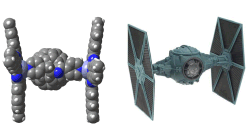 |
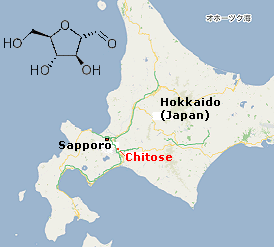 |
ChitoseThis molecule also has the same name as the Japanese city, and is also a common Japanese girl's name. The molecule is a sugar, and gets its name since it's derived from chitin, which comes from the Greek for 'tunic' (chiton). Chitose is one of those molecule names that you have be careful to pronounce, as some people pronounce the 'ch' as 'sh', which makes it sound like an unfortunate toilet accident. Thanks to FengJun for suggesting this molecule. |
 |
RanasmurfinRanasmurfin has nothing to do with the blue cartoon Smurfs from Belgium. But it is blue! It's an unusual blue protein isolated from the nests of a Malaysian tree frog, Polypedates leucomystax. During mating, the female produces a protein-rich fluid that she and the male frog, whip up into a sticky foam nest containing the fertilized eggs. These nests exhibit a variety of colours - when first formed they are usually pale creamy white/orange, but frequently develop a darkblue/green color within a few hours or days. This blue colour is due to the protein ranasmurfin. Thanks to Jan Linders for suggesting this protein. See: M. Oke, et al, Angew. Chem. Int. Ed. 47, (2008) 7853. |
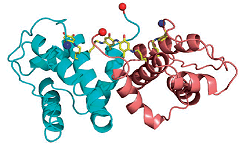 |
Bottle-brush polymersBottlebrush compounds are usually polymers in which the main chain adopts an extremely stiff conformation, which is surrounded by expanded but still flexible side chains, thus making the molecules resemble the bottle-brushes used for cleaning test-tubes and, er, bottles, in any chemistry lab. Thanks to Jan Linders for suggesting this polymer. See: M. Wintermantel, et al, Macromolecules 29, (1996) 978. |
|
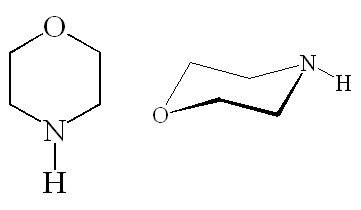 |
MorpholinoA Morpholino sounds like an expensive type of coffee available at Starbuck's ("I'll have a cappucino and my wife will have a morpholino, no sugar"). In fact, Morpholinos are synthetic molecules which result from a redesign of natural nucleic acid structures. They are usually 25 bases in length and they bind to complementary sequences of RNA and modify gene expression. The word "morpholino" can occur in other chemical names, referring to chemicals containing the 'morpholine' ring (shown in the picture). To help avoid confusion between the 2 types of molecules with the same name, when describing the nucleic acid version "Morpholino" is often capitalized. Because of the amine group, morpholine is a base, and it's commonly added in ppm concentrations in power plant steam systems to adjust the pH. Its conjugate acid is given the wonderful name 'morpholinium', e.g. in the salt morpholinium chloride. See: J. Summerton and D. Weller, Antisense & Nucleic Acid Drug Development (1997) 7 187 |
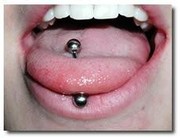 |
Studtite and MetastudtiteStudtite isn't the glue which keeps tongue-studs into place, nor is it the secret formula for Hollywood male actors. It's actually a uranium mineral containing peroxide of formula (UO2)O2·4(H2O) formed by the radioactive decay of nuclear fuel or uranium ores. It occurs as white yellow needle-like crystals, and as a mineral it was named for Franz Edward Studt, a English prospector and geologist who was working in the Belgian Congo. Thanks to Charles Turner for suggesting this mineral. For more info, see webmineral.com. |
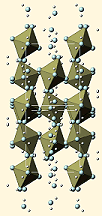 |
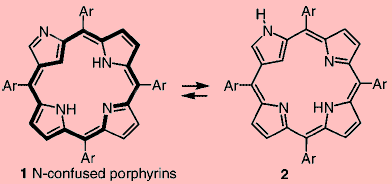 |
N-Confused PorphyrinsIf you thought chemistry was confusing, here's your proof - even the molecules are confused! "N-confused" porphyrins are so named because instead of have 4 N's in the central core, they have 2 or 3, making them asymmetrical. These rings, often called 'mutated porphyrins', are not planar, but are twisted. The core H's can flip from one N to another, making the molecule twist and change shape. No wonder they're confused... Thanks to Joannes T.M. Linders for suggesting this confused molecule. For more info, see J.L. Sessler, Angew. Chem., Int. Ed. Engl. 33 (1994) 1348. |
 |
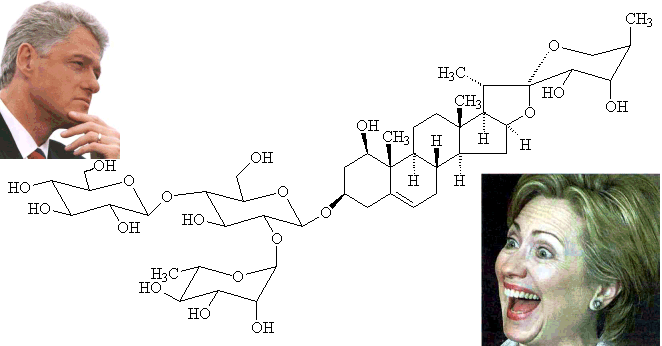 |
ClintoniosideStaying on the presidential theme, clintonioside is not a molecule specially designed to rid the world of the Clintons. It's a steroidal glycoside extracted from the East Asian plant Clintonia udensis. According to the paper below, the rhizomes of this plant have long been used in traditional Chinese medicine for the treatment of fatigue and 'blow' - which is most appropriate given Bill Clinton's past history... Thanks to Joannes T.M. Linders for suggesting this molecule. For more info, see Y. Mimaki, K. Watanabe, Helvetica Chimica Acta 91 (2008) 2097. |
 |
HAMLETIf you take normal α-lactalbumin (see structure, right), and chemically treat it so it folds up in a specific way, you can change it to be (or not to be?) lethal to cancer cells. Thus, we get HAMLET, human alpha-lactalbumin made lethal to tumor cells. So, as the great man said: "Diseases desperate grown, By desperate appliance are relieved, Or not at all." - William Shakespeare, Hamlet, 4.3. Thanks to Joannes T.M. Linders for suggesting this literary molecule. For more info, see M. Svensson, A. Håkansson, A.-K. Mossberg, S. Linse, and C. Svanborg, P.N.A.S. 97 (2000) 4221, or the superbly titled paper "Who Is Mr. HAMLET?", E.L. Knyazeva, V.M. Grishchenko, R.S. Fadeev, V.S. Akatov, S.E. Permyakov, and E.A. Permyakov, Biochem, 47 (2008) 13127. |
|
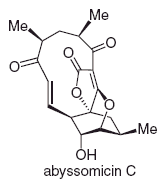 |
AbyssomicinAbyssomicins are a class of antibiotics that were found in marine creatures that were collected from a depth of 289 m below the surface of the Sea of Japan. This habitat, 'the Abyss', decisively influenced the naming of this class of natural product, which became known as abyssomicins. Different versions were given different code letters, B, C (shown left), D, etc, but curiously, the letter A was left out of the naming, as if that privilege was reserved for an important compound yet to be discovered from the same source. Thanks to Joannes T.M. Linders for suggesting this molecule. For more info, see "Discoveries from the Abyss: The Abyssomicins and Their Total Synthesis", K.C. Nicolaou, S.T. Harrison, J.S. Chena, Synthesis, (2008). |
|
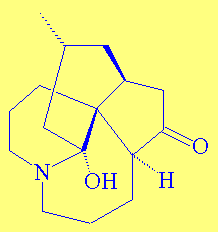 |
FawcettimineUnfortunately, this molecule was not named after Charlie's Angel's star Farrah Fawcett Majors. Instead it was named this way because it was isolated from the Jamaican moss Lycopodium fawcetti. Thanks to Jan Linders for suggesting these molecules. For more info, see: X. Ma and D.R. Gang, The Lycopodium alkaloids, Nat. Prod. Rep. (RSC, 2004), or J. Org. Chem. 1989, 54, 1548. |
 |
Siamese Twin MoleculesIn nature, peptide molecules often cyclise into rings. Sometimes these rings are doubled, with a portion of each ring being shared by each partner. Owing to the resulting proximity of both structurally identical cycles, they have been called 'Siamese depsipeptides', since they resemble conjoined twins or 'Siamese' twins. Two examples made from the starting peptide sansalvamide (SA) are shown in the diagram on the right, where the bold bonds indicate the shared atoms. Thanks to Jan Linders for suggesting these molecules. Ref: Angew. Chem. Int. Ed. 2009, 48, 8564. |
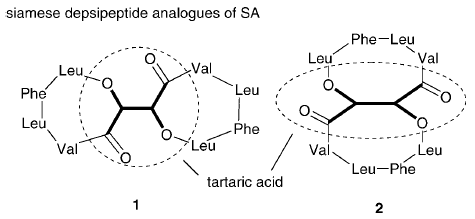 |
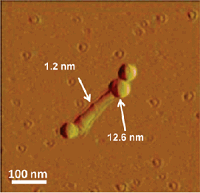 |
NanoPaNTS, Nanokebabs and NanodumbbellsNanopants sound like the clothing required for the Nanoputians we saw earlier. And are nanokebabs what they eat when coming home from the nanopub late at night, just in time for them to do a workout with their nanodumbbells? In fact both these 'molecules' are combinations of nanotubes and nanoparticles. NanoPaNTs are nanotubes that have had metallic nanoparticles attached to their ends using magnetic fields. They can give rise to dumbbell-like structures as shown left. Again using magnetic fields, nanotubes can be made to curl back on themselves to make rings, and straight nanotubes can be threaded through these to make shish-kebab-like structures, as shown right. If you think I'm making all this up, check the reference below... Thanks to Tim Harrison for suggesting these molecules. Ref: J.G. Duque, et al, J. Phys. Chem. C (2009) 113, 18863. |
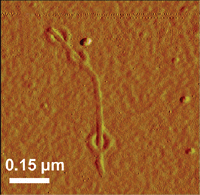 |
DiketeneDiketene should really have a hyphen to make it read di-ketene, but without the hyphen it could be pronounced 'dike-tene' - the favourite molecule of lesbian teenagers? Its name in Dutch is 'diketeen', which sounds like 'dikke teen', which means a fat toe! Thanks to Henk Bosch for suggesting this molecule. Ref: wikipedia. |
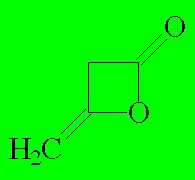 |
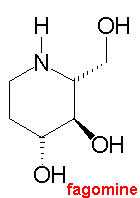 |
Fagomine and FagarineHmm, it's difficult to make any jokes about these molecule names with
being very politically incorrect. But we'll do it anyway. :-) Maybe
'fagomine' is how you'd describe a rent-boy to a friend. Since 'fag' in
the UK is simply slang for cigarette, saying to someone "would you like a
fagomine" is quite innocent. But don't try this in the US... Fagomine was
first extracted from buckwheat seeds (Fagopyrum esculentum Moench)
and has possible uses to treat diabetic disorders. A related compound with
another excellent name, Isofagomine
tartrate, is an experimental drug for the treatment of certain forms
of Gaucher's
disease. Thanks to Arnold Martelli for suggesting thes molecules. Ref: A. Kato et al., J. Nat. Prod., (1997) 60 312; V. Deulofeu et al., Nature, 162, (1948) 694. |
![]()
There are some molecules that I've heard of but don't have information about or I don't know the structure. I'm not even sure if some are genuine molecules. If you can help with any of these, please let me know. They are: Cyrillic Acid, Sarcastic acid, Barbaric acid, Sardonic acid (do any of these 3 exist?),...also baptisin (C26H32O14+9H2O) extracted from the wild indigo plant (Baptisia tinctoria) - anyone have a structure or reference?